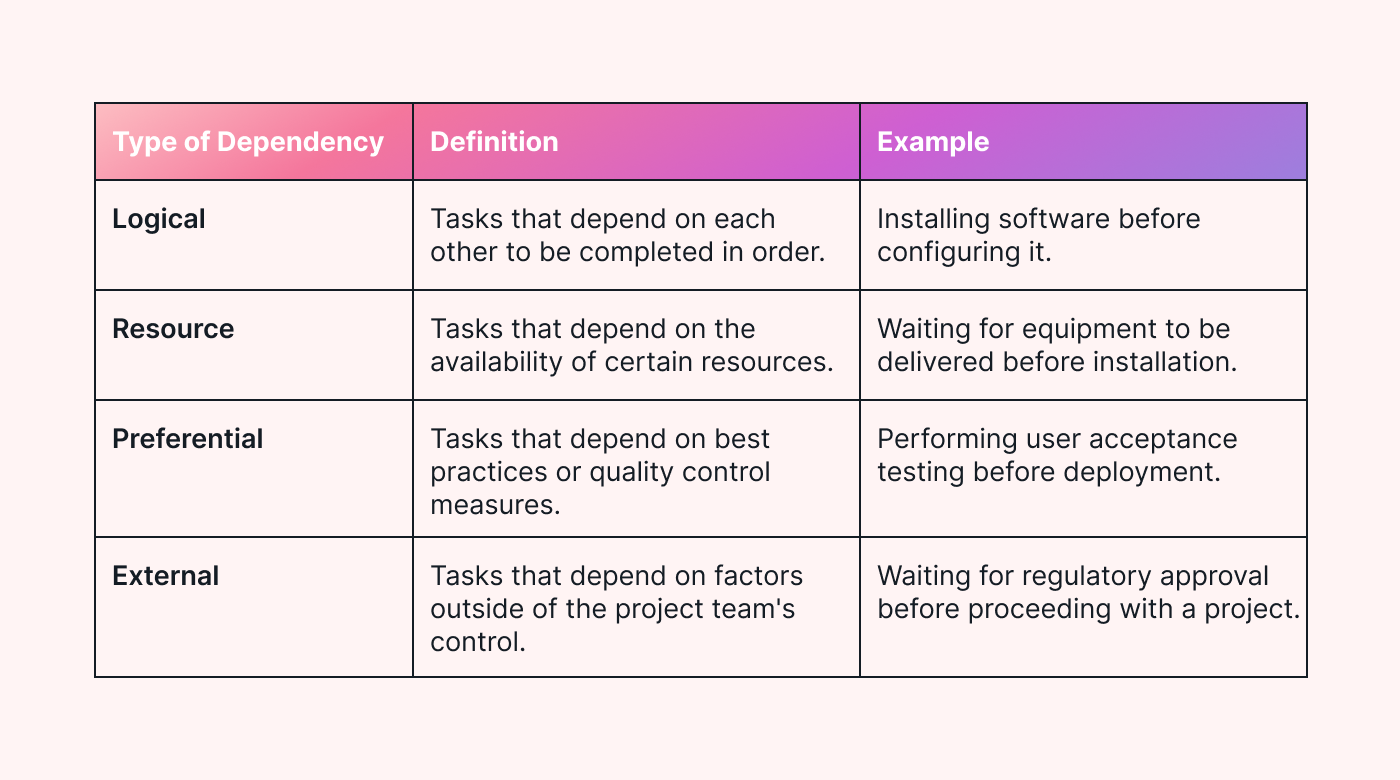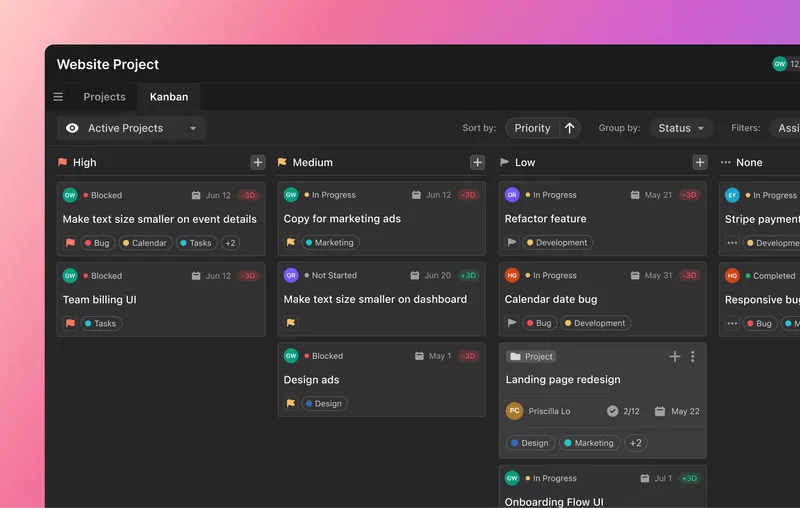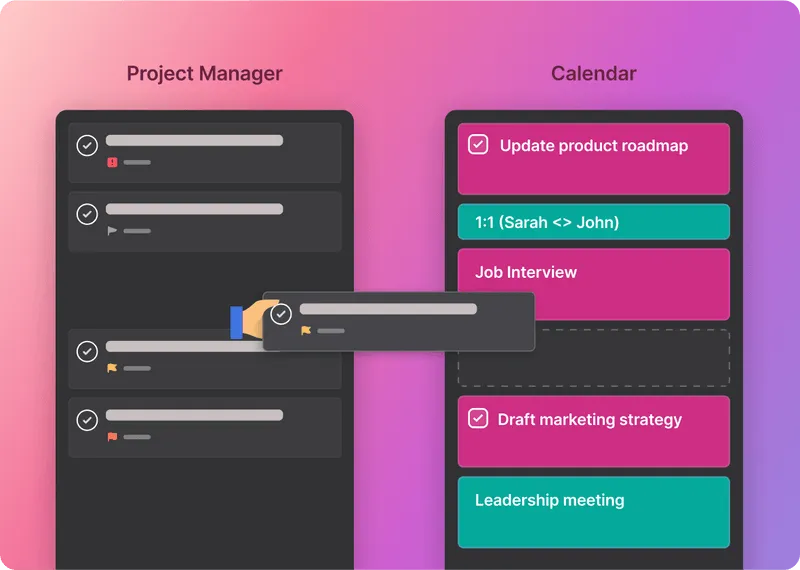Have you ever worked on a project that seemed due to succeed until it suddenly crashed? Perhaps a key team member got sick, a vendor didn't deliver on time, or unexpected challenges emerged.
Whatever the cause, when one part of a project falls behind or gets disrupted, it can have a ripple effect on the entire project. That's why understanding project management dependencies is essential to project success.
In project management, dependencies refer to the relationships between different tasks and activities in the project. These relationships are critical to scheduling.
In this article, we'll:
- Explore the key terms and concepts related to project dependencies
- Explain different types of dependencies and how they can impact project completion
- Discuss common task dependencies and how to manage them
- Offer tips and best practices for identifying, tracking, and mitigating dependencies
Let's dive right in.
What are dependencies in project management?
Project dependencies play a crucial role in the successful execution of projects. They define the connections and interdependencies between tasks or activities. This dictates their order or sequence.
Each task needs to finish in the correct order for the project to proceed smoothly, like a set of dominoes.
Let's consider a few simple examples of dependencies to help illustrate this. In a construction project, pouring the foundation depends on excavating the site and preparing the ground. In software development, designing the user interface relies on completing the wireframing.
These examples highlight the interconnections of tasks and how they rely on one another for progress.
Important terms and concepts for dependencies
Understanding terms and concepts related to project dependencies is essential for effective management. Below, we'll explore two key concepts: project constraints and the critical path, and blockers.
Project constraints and the critical path
Project constraints refer to the limitations or restrictions that impact the project's execution. These can include factors such as:
- Budgetary constraints
- Resource availability
- Time constraints
- Or regulatory requirements
Next, the critical path represents the longest sequence of dependent tasks. Tasks along the critical path have no flexibility and have strict completion times.
This allows project managers to make informed decisions, divide resources efficiently, and manage project execution.
Blockers and their impact on project dependencies
Blockers are obstacles or issues that impede the progress of project tasks. These blockers can arise from various factors, including:
- Unforeseen challenges
- Resource unavailability
- Technical issues
- Communication gaps
- Or external influences
When blockers occur, they can have a significant impact on a project. For instance, if a critical vendor fails to deliver on time, delays can occur on dependent tasks. This delay results in a ripple effect throughout the project timeline.
Let's consider a software development project as another example. If there is a sudden change in the project requirements, it can impact the development timeline. This impact can affect the team's workload and the project outcome.
Resolving blockers is essential to mitigating their impact on project dependencies.
Types of dependencies
Understanding the different dependencies allows project managers to plan and execute projects effectively.
 |
Let's explore the various types of dependencies in the sections below.
Logical dependencies
Logical dependencies establish the sequential order of tasks in project management. These dependencies result in a logical flow of work.
For example, creating the foundation is a logical dependency for building the walls in a construction project. It wouldn't be practical to construct the walls without the foundation.
In marketing, conducting market research is a logical dependency for creating a targeted ad. Gathering relevant data and insights before formulating an effective marketing plan is essential.
Identifying and managing logical dependencies allows project managers to:
- Establish a clear project timeline
- Prioritize tasks effectively
- And minimize delays or disruptions
Resource dependencies
Resource dependencies are when tasks rely on the availability of specific resources. These often directly impact project timelines and the execution of tasks.
For example, a graphic designer with expertise in a particular style or software is necessary for a crucial design project.
In construction, the installation of electrical wiring depends on the availability of electricians.
Effective resource allocation guarantees the availability of required resources at the right time.
Preferential dependencies
Preferential dependencies ensure quality and adherence to best practices in a project. They aren't based on a sequence or resource need, but on recommended guidelines or quality control measures.
These dependencies focus on key tasks or activities that are critical for success.
Here are a few examples of preferential dependencies in a project:
- Conduct a thorough quality assurance review before releasing a software update.
- Seek input from subject-matter experts during the design phase of a product.
- Prioritize user testing and feedback before finalizing a website design.
External dependencies
External dependencies can be fatal but aren't beyond the project team's control. These dependencies often involve third-party vendors, regulatory requirements, or external stakeholders.
Here are a few examples of external dependencies in a project:
- Reliance on a supplier for the timely delivery of materials.
- Compliance with government regulations or industry standards.
- Integration with external systems or APIs provided by third-party providers.
A thorough risk evaluation plan can help mitigate their impact on the project. A great one can remove the risk altogether.
Other types of dependencies
Internal dependencies: Internal dependencies are the opposite of external dependencies with the team in control. The dependency relationship does not rely on third parties.
Direct dependencies: Direct dependencies are when task A depends on task B entirely.
Indirect dependencies: Indirect dependencies, also known as transitive dependencies, are when task C depends on task B, so task C depends on task A indirectly.
Types of task dependencies
Task dependencies are often classified into four main types. Each indicates the relationship and order between tasks.
Using a flowchart or fishbone diagram to identify the types of tasks can be useful.
Finish to Start (FtS) and its common use in project management
FtS is the most common and straightforward type of task dependency. It shows the sequential order that asks must follow for success.
Imagine FtS: is a cooking recipe. You can't start baking a cake until you have finished mixing the batter. The completion of one step paves the way for the next steps, and so forth, until you have a yummy cake (or project success).
Finish to Finish (FtF) and how it affects tasks with subtasks
FtF is a task dependency, where one task can't be completed until another specified task has.
Imagine FtF: is painting a picture. The background isn't finished until the foreground is, even if some of the background details were already completed.
Let's consider writing a report as another example. The editing task isn't complete until the proofreading task is, even if individual sections of the report were already edited.
Start to Start (StS) and its importance for parallel tasks
StS dependencies are tasks that can start together but need one task to start before the other can finish.
The start of one task influences the start and progress of the other.
Imagine StS: is a meeting. The meeting can’t end until the agenda is discussed.
Start to Finish (StF) and its use in unique situations
StF dependencies are the reverse of Finish to Start dependencies. In StF relationships, one task needs to start before another task can finish.
Imagine StF: in a relay race. The final runner can't finish the race until they receive the baton from the previous runner. The previous runner's action begins the completion of the race for the final runner.
Start to Finish dependencies are less common, but are also valuable to understand.
Tips for managing dependencies
Managing dependencies allows for a better workflow, less risk, and more reward.
To help you, here are three tips for project dependency success.
Identifying and tracking dependencies
Identify and track dependencies proactively to address potential issues.
Visual aids like Gantt charts and Kanban boards help visualize dependencies and their timelines. Project management software like Motion can support tracking and managing tasks across teams.
 |
Reviewing and updating tasks can also help with accurate planning and resource division. This also reduces delays and bottlenecks.
Communication and collaboration
Effective communication and collaboration are key to managing dependencies successfully.
Frequent check-ins allow team members to stay updated and address dependencies proactively. Clear communication means everyone understands their roles and responsibilities.
Project management software like Motion can help focus communication and improve team dependency management.
Mitigating risks and addressing blockers
Mitigating risks and promptly addressing blockers can mitigate disruptions and lead to project success.
Creating contingency plans helps prepare the team to respond effectively to different scenarios. Anticipating potential blockers through risk assessment helps minimize their impact on project timelines.
Quick tips for addressing blockers include:
- Identifying and prioritizing critical dependencies
- Involving stakeholders early
- Seeking alternative solutions
- And escalating issues when necessary
How Motion can help manage project dependencies
Motion allows you to easily track and visualize dependencies, collaborate with your team, and proactively address potential blockers. Motion's algorithm considers dependencies and schedules your tasks in the correct order.
 |
And for those looking for an even more streamlined solution, Motion provides an AI-powered calendar. The AI automatically plans a day based on deadlines, working hours, task links, and resource meetings.
With Motion, you can stop worrying about coordinating your team and always know whether they're on track. It reduces manual planning and frees up time to focus on other aspects of the project.
Try Motion with a 7-day free trial.






